Related Research Articles

Secretariat, also known as Big Red, was a champion American thoroughbred racehorse who was the ninth winner of the American Triple Crown, setting and still holding the fastest time record in all three of its constituent races. He is considered by many to be the greatest racehorse of all time. He became the first Triple Crown winner in 25 years and his record-breaking victory in the Belmont Stakes, which he won by 31 lengths, is widely regarded as one of the greatest races in history. During his racing career, he won five Eclipse Awards, including Horse of the Year honors at ages two and three. He was nominated to the National Museum of Racing and Hall of Fame in 1974. In the Blood-Horse magazine List of the Top 100 U.S. Racehorses of the 20th Century, Secretariat was second to Man o' War.
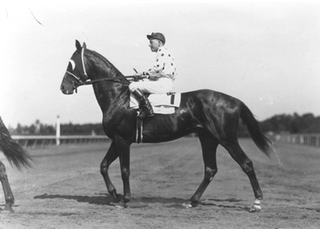
Omaha was a champion American Thoroughbred racehorse who is the third winner of the American Triple Crown.
Bold Ruler was an American Thoroughbred Hall of Fame racehorse who was the 1957 Horse of the Year. This following a three-year-old campaign that included wins in the Preakness Stakes and Trenton Handicap, in which he defeated fellow Hall of Fame inductees Round Table and Gallant Man. Bold Ruler was named American Champion Sprinter at age four, and upon retirement became the leading sire in North America eight times between 1963 and 1973, the most of any sire in the twentieth century.
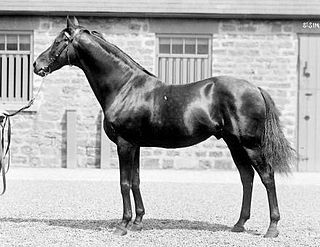
St. Simon was an undefeated British Thoroughbred racehorse and one of the most successful sires in the history of the Thoroughbred. In May 1886 The Sporting Times' carried out a poll of one hundred experts to create a ranking of the best British racehorses of the 19th century. St. Simon was ranked fourth, having been placed in the top ten by 53 of the contributors.
Charismatic was an American Thoroughbred racehorse best known for winning the first two legs of the Triple Crown of Thoroughbred Racing in 1999.

Salvator (1886–1909) was an American Hall of Fame Thoroughbred racehorse considered by many to be one of the best racers during the latter half of the 19th century.

Rags to Riches is a retired champion American Thoroughbred racehorse who won the 2007 Belmont Stakes, the first filly to win it in over a century.
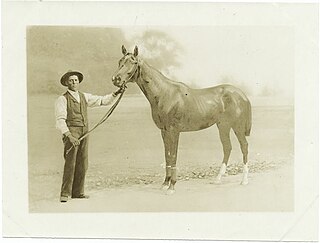
Luke Blackburn (1877–1904) was a thoroughbred race horse born and bred in Tennessee by Capt. James Franklin. He was inducted into the US Horse Racing Hall of Fame in 1956.
Proctor Knott was an American Thoroughbred racehorse gelding. His sire was the Hall of Famer Luke Blackburn, and his dam Tallapaloosa. He was bred by Belle Meade Stud and like his father, who had been named for the then-current governor of Kentucky, he was named for Governor J. Proctor Knott. He was owned during his racing career by George Scoogan and Sam Bryant, who purchased him at auction for $450.
The 1889 Kentucky Derby was the 15th running of the Kentucky Derby, won by Spokane. The race took place on May 9, 1889. The winning time of 2:34.50 set a new Derby record for a distance of 1+1⁄2 miles (2.4 km), and remains the Derby record for the distance This was the first Derby where $2 win wagers were available.

Frankel is a retired champion British Thoroughbred racehorse and current sire. He was unbeaten in his fourteen-race career and was the highest-rated racehorse in the world from May 2011. He was trained by Henry Cecil in Newmarket and ridden in all his races by Tom Queally.
Nadir was a Thoroughbred racehorse who was one of two colts voted the American Champion Two-Year-Old Colt of 1957. He was bred and raced by Bull Hancock's Claiborne Farm.

Formosa (1865–1881) was a British Thoroughbred racehorse that was the first winner of the English Fillies Triple Crown in addition to running a dead heat with the colt Moslem for the 2,000 Guineas Stakes. Formosa was bred by James Cookson and was foaled in 1865 at his Neasham Hall stud farm. Formosa was sold to William Graham in 1866 and raced her entire three-year racing career under his ownership. After her racing career ended in 1871, she became a broodmare for Graham until his death in 1876. Formosa was exported to France in 1879 and died there in February 1881. While she did not produce offspring that excelled at racing, her daughters that were exported to Germany and New Zealand did produce descendants that were successful racers.
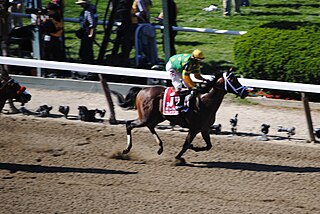
Palace Malice is an American Thoroughbred racehorse best known for winning the 2013 Belmont Stakes. After winning one minor race as a two-year-old he made steady improvement in the early part of 2013, being placed in the Risen Star Stakes and Blue Grass Stakes and running prominently in the Kentucky Derby before winning the Belmont Stakes, and the 2014 Metropolitan Handicap. He went on to win the Jim Dandy Stakes and finish second against older horses in the Jockey Club Gold Cup. As a four-year-old in 2014 he won his first four races including the Gulfstream Park Handicap, New Orleans Handicap and Metropolitan Handicap. After two races in 2015, he was retired as a five-year-old and sent to stand at stud at Three Chimneys Farm.

Wicked Strong is an American Thoroughbred racehorse. He established himself as a contender for the 2014 Kentucky Derby with a win in the Wood Memorial Stakes. He finished fourth in both the Kentucky Derby and the Belmont Stakes before winning the Jim Dandy Stakes.
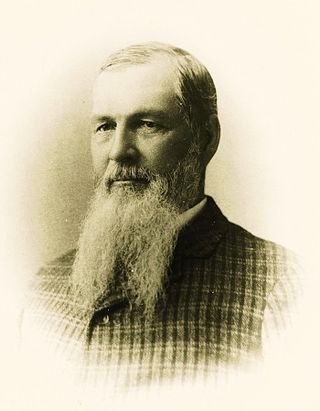
Noah Armstrong was a superintendent of the Glendale smelter and discoverer of the Hecla Mine in western Montana. Later in life he moved to Seattle, where he established the Seattle Transfer Company.
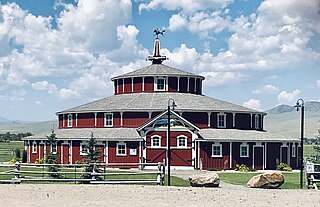
The Doncaster Round Barn, also called "Bayers' Barn" and "the Round Barn at Twin Bridges" is a three-story, wood-framed round barn located about 1.5 miles (2.4 km) north of Twin Bridges, Montana. Built about 1882 by mining entrepreneur Noah Armstrong to house his race horses, and featuring a 20 feet (6.1 m)-wide indoor circular aisle that was used for exercising horses, it is a National Register of Historic Places property notable for its unique architecture and as the birthplace of the Thoroughbred racehorse, Spokane, winner of the 1889 Kentucky Derby.

Nyquist is a champion American Thoroughbred racehorse who won the 2016 Kentucky Derby and 2015 Breeders' Cup Juvenile, only the second horse to complete the Juvenile-Derby double. He became the eighth undefeated winner of the Kentucky Derby, and the first since Big Brown in 2008. He received the 2015 Eclipse Award for Champion Two-Year-Old. He is the second Kentucky Derby winner after Morvich to win the race while undefeated after winning Champion Two Year Old the year before, and then never winning again.

Exaggerator is a retired American Thoroughbred racehorse, winner of the 2016 Preakness Stakes. Racing as a two-year-old in 2015, he won three of his six starts including the Saratoga Special Stakes and the Delta Jackpot Stakes as well as finishing second in the Breeders' Futurity and fourth in the Breeders' Cup Juvenile. The following spring, he finished second in the San Vicente Stakes and third in the San Felipe Stakes before establishing himself as a contender for the 2016 Kentucky Derby with a six length win in the Santa Anita Derby. After finishing second to Nyquist in the Derby, he turned the tables to win the 2016 Preakness Stakes. He ran poorly in the 2016 Belmont Stakes but defeated Nyquist again in the Haskell Invitational. Tactically, Exaggerator was a "closer" – one who prefers to come from behind in his races.

Surefoot was a British Thoroughbred racehorse and sire whose exceptional racing ability was combined with a violent and unpredictable temperament. As a juvenile in 1889 he was regarded as the best colt of his generation in England after winning three of his four races including the Woodcote Stakes and New Stakes. He also demonstrated his precocity by reportedly siring a foal as a two-year-old. In 1890 he was an emphatic winner of the 2000 Guineas but despite being regarded as a near certainty for the Epsom Derby he finished fourth after spending much of the race attempting to savage other horses and jockeys. He went on to win a minor race at Royal Ascot and later defeated a strong field to take the valuable Prince of Wales' Stakes at Leicester Racecourse. As a four-year-old he showed little worthwhile form early in the season but returned to his best to win the Eclipse Stakes. After his retirement from racing he stood as a breeding stallion in England and France but had limited success as a sire of winners.
References
- ↑ Noah Armstrong
- ↑ "Media Guide - Birthplaces". Kentucky Derby Media Guide. 2023.
- ↑ Briggeman, Kim. "1889 Derby Winner Directed National Attention to Iconic Round Barn in Twin Bridges". Missoulian, May 3, 2015 edition. Accessed May 3, 2015.
- 1 2 3 4 5 6 Mooney, Bill (30 April 2014). "Spokane, the Kentucky Derby winner of 1889, a part of Montana folklore". Daily Racing Form. Retrieved 10 June 2023.
- 1 2 "Montana's Pride". The Independent-Record. 10 May 1890. p. 1. Retrieved 9 June 2023.
- 1 2 3 4 5 "Royal Derby - Spokane Defeats the Favorite". The Courier-Journal. 10 May 1889. p. 1. Retrieved 9 June 2023.
- 1 2 3 Kentucky Derby Media Guide. Louisville, KY, USA: Churchill Downs. 2012. p. 127.
- 1 2 "Spokane the Victor - Noah Armstrong's Colt Captures the Great American Derby". The Chicago Tribune. 22 June 1889. pp. 9–10. Retrieved 9 June 2023.
- ↑ "Spokane's Great Victory". The Sun. 15 May 1889. p. 1. Retrieved 9 June 2023.
- ↑ "Won By Proctor Knott". The Chicago Tribune. 5 July 1889. p. 1. Retrieved 9 June 2023.
- 1 2 3 Spokane's pedigree and partial racing stats
- ↑ Spokane's Kentucky Derby
- ↑ "Poor Spokane - The Gallant Derby Winner Will Never Face The Starter Again". The Spokane Daily Chronicle. 14 November 1890. p. 5.
- ↑ "Noah Armstrong Home". The Helena Independent. 20 November 1890. p. 5. Retrieved 9 June 2023.
- 1 2 "Poor Old Spokane". Spokane Chronicle. 2 December 1898. p. 3. Retrieved 9 June 2023.
- ↑ "Famous Horses Sold Ridiculously Low". Lexington Herald-Leader. 23 December 1898. p. 2. Retrieved 9 June 2023.
- ↑ Official Catalogue, Sixteenth Annual Horse Show, Madison Square Garden. New York City. 1990. p. 124.
{{cite book}}: CS1 maint: location missing publisher (link)
- Nardinger. "Spirit Horse of the Rockies" (1988) Falcon Press Pub. Co. (dist) ISBN 0-937959-48-0